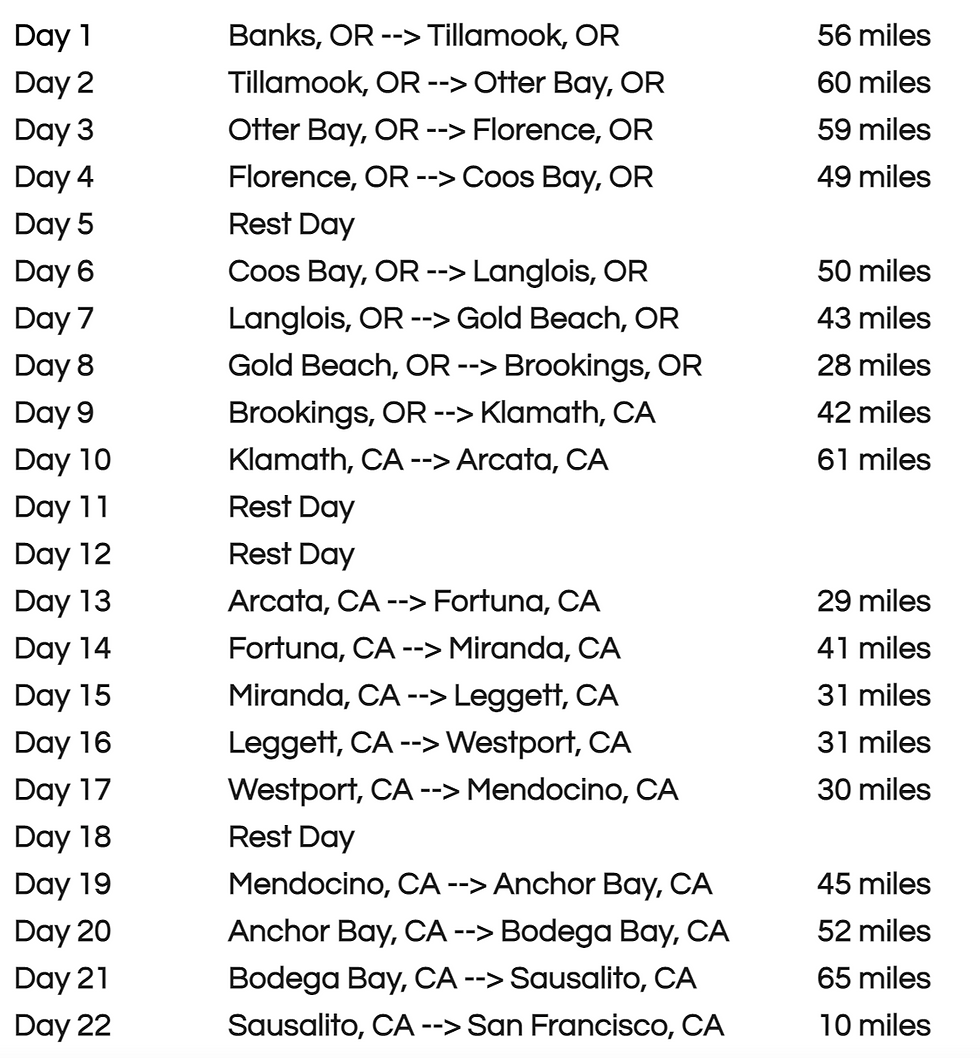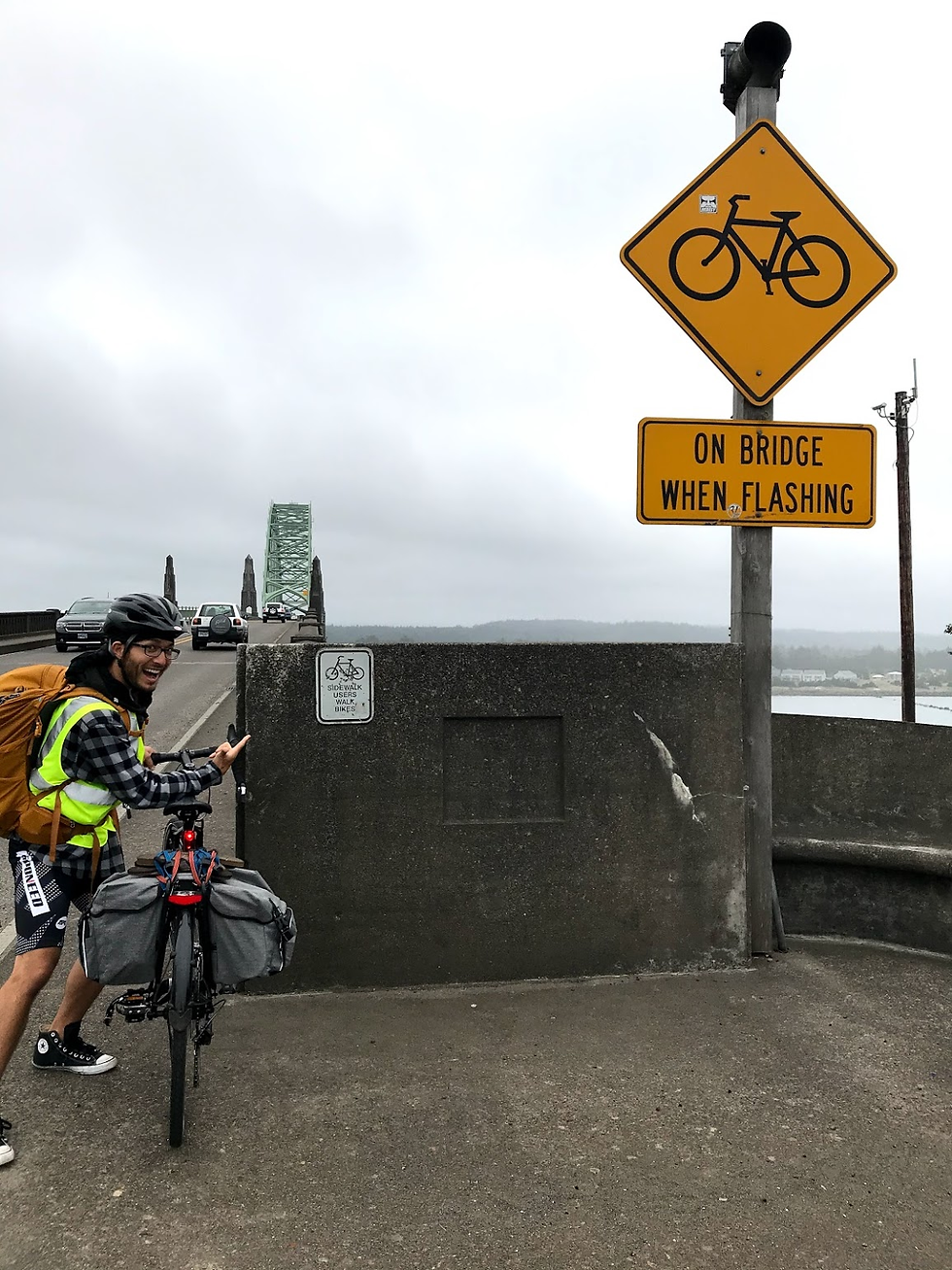Biking From Portland To San Francisco: Logistics for Non-Bikers
- Cory Howell Hamada

- Oct 1, 2020
- 5 min read
Updated: Dec 1, 2020

We stopped in Trinidad for caffeine and a snack. Lilly got into a conversation with a couple at the neighboring table about the trip, and they got curious not just about the what, but the how.
“Well, here’s the thing,” I said, “we’re not really bike-people.”
They gave me a confused look.
Not bike people? But the shorts. The vests. The bikes.
We’ve had the same conversation a number of times, and the reaction is always the same: You’re clearly bike-people.
But we’ve never thought of ourselves as bikers or cyclists or bike-people. Even for those few years when I was riding my bike to work, it was more for exercise and environmental reasons. I didn’t do it because I was a bike-person.
And to do something like the trip, you don’t need to be a bike-person. You just need to be a person.
1. What’s In the Pack
2. Pre-Trip Training
3. Bike Skills
4. Planning the Mileage
5. Smelling the Roses vs. Doing Mileage
6. Bridges, Tunnels, Hills: Significant Obstacles
7. Requisite Call To Action
1. What’s In the Pack
Lilly and I had almost the same things in our packs, but I carried the repair equipment, and she carried the snacks. I carried our computers in a backpack.
Clothes:
-Hoodie (1)
-Flannel (1)
-Jean shorts (1)
-Sweatpants (1)
-Rain Jacket (1)
-Bike Shorts (2)
-Running Shorts (1)
-Tank top (1)
-Shirts (6)
-Underwear (3)
-Socks (4 pairs)
Repair Equipment:
-Spare Tire (1)
-Spare Tubes (2)
-Pump (1)
-Chain (1, with extra master links)
-Tire levers (1 pair)
-Chain link removal tool (1)
-Tube patch kit (1)
-Swiss army knife (1)
-Flathead screwdriver (1)
-Adjustable wrench (1)
Misc:
-Tarp (1; 6’x8’)
-Bungees (5; three two-footers, two one-footers)
-U-Lock (1)
-Pens (5)
-Notebook (1)
-Old Terrorists by Murakami Ryu
-The Uninhabitable Earth by David Wallace-Wells
-Toiletries (in a 1-gallon baggie)
-Reusable Bag (1)
-Garbage Bag (2)
2. Pre-Trip Training
We trained semi-seriously for four months. The goal was to build up to 60 miles.
We also wanted to dance and work during the training period, so the goal was to train without having it take over our lives. We generally trained 2-3 times a week.
Month 1: Get on a bike. Be in the saddle for an hour.
Month 2: Regular rides of 12-17 miles. A weekly “long” ride of 25-30 miles.
Month 3: Regular rides of 20-25 miles. A weekly “long” ride of 40-45 miles.
Month 4: Regular rides of 25-40 miles. Two “long” rides, one 50 miles, another 60 miles.
We tried to make the training fun. We stopped for snacks, brought water, usually had a goal of getting food or lunch along the way.
3. Bike Skills
We’re not handy, but we learned basic bike maintenance before the trip:
-Put air in tires
-Patch a tube
-Change a tube
-Change a tire
-Change a chain
-Adjust brakes
We learned from YouTube. Anything more difficult, the plan was to go to a bike shop.

4. Planning the Mileage

Since we’d built up to 60 miles in training, we had a maximum range for each day. Each day’s route depended on finding a place to stay within 60 miles of the next spot.
We tried to get off the 101 when we could. We took the Three Capes Scenic Route from Tillamook, and Seven Devils from Coos Bay. When we found bike paths, we took them.
Some days we went a little over 60 miles--and those rides were difficult. We also planned some rest days, which ended up being very necessary.

We consulted Google Maps and planned lunch stops wherever we could find a community with a restaurant or grocery store.
There are long stretches (up to 25 miles) on the route without any restaurants or stores. We planned food and water stops before hitting those stretches.
We also paid close attention to the elevation profile of each day. We used Google Maps to route how far and when we’d have to bike uphill. A few hundred feet of elevation can make for a much harder ride.
For instance, Florence → Coos Bay (Day 4) versus Anchor Bay → Bodega Bay (Day 20):

The two routes have a similar mileage, but an extra 900 feet of elevation can make for a more difficult ride. Florence to Coos Bay has two crazy hills, Anchor Bay to Bodega Bay is lots of moderate up and down.
The suggested time Google gave us was not accurate to our riding style; we were slower.
5. Smelling the Roses vs. Doing Mileage
This isn’t something I feel I ever got totally “right.” I generally wanted more time to stop and enjoy, but we were also constrained by time and budget.
Day 21, we met Rex. Rex is a serious biker who blew past us on his ride, then doubled back to ride a few miles with us and chat. He was excited that we were on a tour, he told us touring changes lives.
He also mentioned that he’s toured with friends who only cover 10 or 12 miles a day. They stop every few miles, walk along the beach. Stop for lunch, have a beer. Stop for coffee, sit and chat. He said it bugged the daylights out of him. He’d rather power through 90 or 100 miles.
When he told us that, I realized there isn’t a right way to do the mileage.
The goal had always been to get to our destination safely, and enjoy the ride as much as we could. In that sense, we hadn’t been wrong.

6. Bridges, Tunnels, Hills: Significant Obstacles
While planning the trip, we read several blogs about biking Portland to SF.
A few mentioned how bad the riding conditions are because of dangerous roads and obstacles. Some made me legitimately fearful for our safety.
I’m glad that we knew about the obstacles. The bridges along the Oregon Coast (the Newport and Coos Bay bridges in particular) are scary. The tunnels along the way are scary. The stretches of the 101 with no shoulder are scary.
But the route is very doable. We wore bright yellow vests and had tail lights. We made ourselves visible. If the bridges didn’t have a clear bike lane, we walked. We didn’t take risks.
Most of the motorists on this route know there are a lot of bikers, and they looked out for us.
We also consulted the ODOT and Caltrans websites so we knew if there were any significant road closures or construction.
Every time we encountered an obstacle, we erred on the side of caution. And thankfully, we were fine.

7. Requisite Call To Action
Lilly and I had a joke: By the end of this, either we’re never going to want to ride a bike again, or we’ll be addicted to touring.
Now that it’s over, I find myself craving the adventure. I’m craving the feeling of moving from place to place, of using my own body to travel, of problem solving, seeing new things, talking to new people, being out in the world.
You don’t need to be a bike person to do a bike tour.
You don’t even need to do a bike tour to have an adventure.
Just get out there. Do something. Try something new.
I’m thankful I did.







Comments